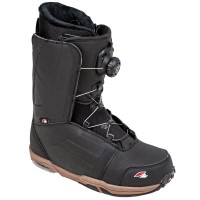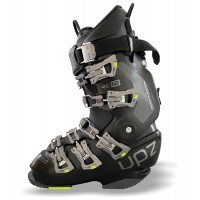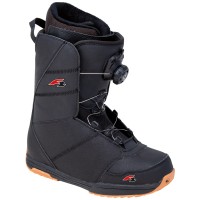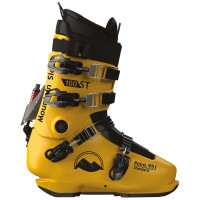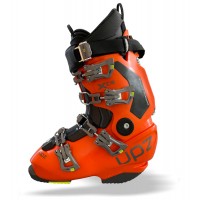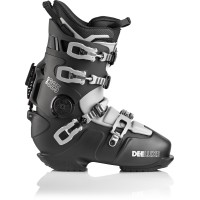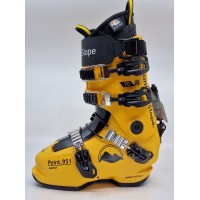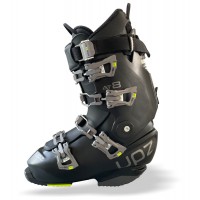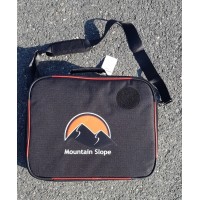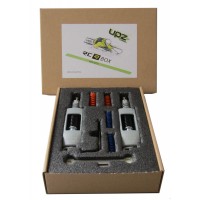Snowboard Hard & Soft Boots
Alpine snowboard boots aka hardboots are made of a hard plastic shell and a liner. Alpine snowboard boots are usually called hardboots. They differ from ski boots in more fore-aft ankle flexibility and in that the soles are beveled to avoid dragging in the snow during deep carves. Some people are turned off by snowboarding in hardboots because they assume the boots are uncomfortable, or not as warm as regular snowboard boots. Because of the design differences between ski boots and hard-shell snowboard boots - softer plastic, more fore-aft flex, and the more widespread use of heat moldable liners for hardshell snowboard boots - hardboots are often just as, if not more, comfortable than most softboots because they offer more support and do not use strap bindings which tend to put pressure on the top of people's feet when strapped in tight for more edge control.
Snowboard soft boots provide riders with the flex, comfort and support needed for freestyle, sbx and freeride boarding. Soft boots have different flex ratings, ranging from soft to stiff. Boot flex is a personal preference but generally a softer flex is chosen by park and beginner riders. For advanced, sbx riders, all mountain riders and freeriders, a stiffer flexing boot is often favoured. Boot flex ratings are not necessarily standardised from one manufacturer to the next, so flex may vary from brand to brand.
All snowboard boots should fit snugly, but not to the point where they cause pain. Most boots need several days of riding for them to pack out and form to their true size, and as a result should be fairly tight when brand new.
Refine Search
DEELUXE Track 700
DEELUXE Track 700 - Alpine hardboots for different snowboarders and different styles DEELUXE Track..
F2 Eliminator Dual
F2 Eliminator Dual - DUAL TGF soft boots with optimum fitF2 ELIMINATOR DUAL - Extreme..
MOUNTAIN SLOPE Point.951 Race Department (130RD)
MOUNTAIN SLOPE Point.951 Race Department (130RD) - The evolution of the legendary Poi..
PALAU Alpine Dual HV
PALAU Alpine Dual HV - High performance tight fitting thermo linerThe DUAL HV liner from the A..
UPZ RCR
UPZ RCR hardboots - Superstiff race alpine hardboots with optimum fit UPZ RCR - Top racing boot for..
MOUNTAIN SLOPE Point.951 World Cup (120WC)
MOUNTAIN SLOPE Point.951 World Cup (120WC) - The evolution of the legendary Point.950..
PALAU Alpine Dual MV
PALAU Alpine Dual MV - High performance tight fitting thermo linerThe DUAL HV liner from the A..
UPZ RC12
UPZ RC12 hardboots - Superlight race alpine hardboots with optimum fit UPZ RC12 - Top rac..
F2 Eliminator Carve
F2 Eliminator Carve - DUAL TGF soft boots with optimum fitF2 ELIMINATOR CARVE - ..
MOUNTAIN SLOPE Point.951 Standard (100ST)
MOUNTAIN SLOPE Point.951 Standard (100ST) - The evolution of the legendary Point.950 MO..
PALAU Alpine Power HV
PALAU Alpine Power HV - High performance tight fitting thermo linerThe POWER HV liner from the..
UPZ XCR Limited Edition
UPZ XCR Limited Edition hardboots - Superlight extreme carve alpine hardboots with optimum fit UPZ ..
DEELUXE Track 325
DEELUXE Track 325 - Recreational symetric alpine hardbootsDEELUXE Track 325 - Legendary boot f..
MOUNTAIN SLOPE Point.951 Junior (70JR/90JR)
MOUNTAIN SLOPE Point.951 Junior (70JR/90JR) - The evolution of the legendary Point.950 ..
PALAU Alpine Power MV
PALAU Alpine Power MV - High performance tight fitting thermo linerThe POWER HV liner fro..
UPZ AT8
UPZ AT8 hardboots - Superlight recreational alpine hardboots with optimum fit UPZ AT8 - A midd..
MOUNTAIN SLOPE Hardboot Bag
MOUNTAIN SLOPE Hardboot Bag Transport your precious boots proper way. Sizes..
PALAU Alpine Classic HV
PALAU Alpine Classic HV - Pre-molded liner, completely thermoformable to greatly enhance ..
UPZ RCR Box
UPZ RCR Box - Advanced damping system for all UPZ alpine hardboots Benefits of the new UPZ RCR..
PALAU Alpine Classic MV
PALAU Alpine Classic MV - Pre-molded liner, completely thermoformable to greatly enh..

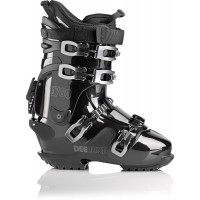
 Ask for Price
Ask for Price